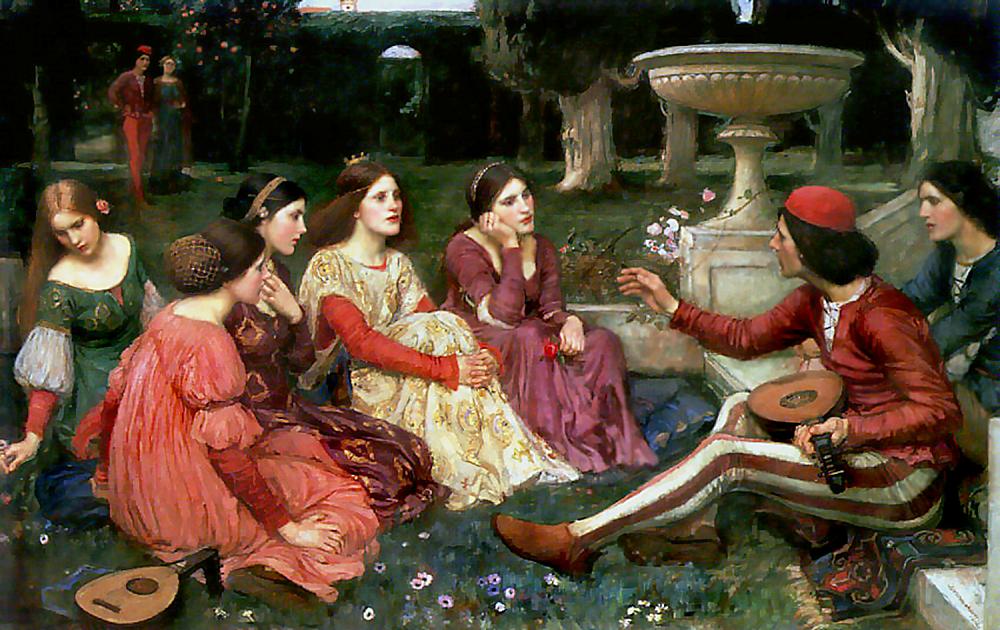uncomfortably familiar?
It is the mid-1300's, and the Black Death, a plague that will eventually kill an estimated half, and maybe as much as two-thirds, of the population of Europe will contnuee for three years. In Italy the pandemic is raging through cities such as Florence. Needing to get away from the horrific images and dangers of the tightly-populated city, seven young women and three young men trek to the outlying rural area where they plan to stay ten days (decameron) at lavish villas.
There is no Wi-Fi.
To pass the time agreeably, they decide to entertain one another telling stories, one per person per day, for a total of 100 tales.
The stories can be anything, myths, folk tales, legends, noble chivalric pieces, tragedies. More often than not, though, they are racy/raunchy stories, elaborate jokes, trickseter tales, satires of the aristocracy and religious (nuns, friars, prelates).
Boccaccio's Decameron is one of literature's most-famous and beloved "frame tales"--a series of short stories with a narrative frame that links them all, in this case the plague that drives them from the city and sets them up to tell the stories. Other famous frame tales are Chaucer's The Canterbury Tales, an uncompleted collection that follows a number of pilgrims traveling to Canterbury Cathedral who decide to make a nightly competition of storytelling. Many of the tales in Chaucer's work were also in Boccaccio's earlier book, yet Chaucer claimed not to have read The Decameron. We know he did read some translations of individual stories, but the main reason for the overlap is these were widely-known stories of the time; they made their way around Europe in various forms that people like Chaucer would have re-worked for their own purposes.
Another quite-famous frame story is One Thousand and One Nights, the story of King Shahryar and Scheherazade. Most of the tales (yes, including "Aladdin") come from the Islamic Golden Age (about 700-1400), but the completed compilation of Arabian, Persian, Indian, Jewish, and miscellaneous other stories with its frame appeared a bit after Boccaccio, about 1450. This book has a tell-a-great-story-or-die frame. The King learns his brother's wife is unfaithful, and this disturbs him. Next he learns his own wife is unfaithful, and he has her killed. Bitter and assuming all women are faithless, he marries daily, sleeps with his new wife, and has her killed the next morning. The eligible women are starting to get very nervous. Scheherezade, it turns out, is lovely, but she is also very smart. Not only does she know a wealth of tales, but her timing is wonderful. When they marry, she puts off the honeymoon night (and her inevitable death) by telling the king a story so compelling that he must hear the end. Each night, claiming exhaustion, she promises to complete the story the next day. The king is hooked; the tales go on for years, by which time the king's icy heart has melted; he finally acknowledges he is very much in love and they live happily ever after. That is a much more elaborate frame tale.
influences?
The Decameron is a much-celebrated work of medieval literature which influenced a great many writers. To be fair, though, it was influenced by the popular tales, some contemporary but most quite old, of the time.
Dante's Divine Comedy, published just about thirty years before The Decameron, also had a strong influence on the work. Not only did Boccaccio learn from Dante's exaborate structuring, but the blend of historical, mythological, and contemporary socio-political elements demonstrated how diverse subjects and styles could live next to one another in the same book.
As for the book's influence on those who came after, well, here is a brief article from Wikipedia (sure, I sometimes look at Wikipedia) that looks just at the Patiend Griselda tale (Day 10, Story 10):
Griselda appears in tales by Petrarch (died 1374, Historia Griseldis published 100 years later) and by Chaucer (The Clerk's Tale in The Canterbury Tales, late 1300s). She is also cited in Christine de Pizan's The Book of the City of Ladies. Patient Griselda [fr] is a tale by Charles Perrault (1691). John Phillip's play The Commodye of Pacient and Meeke Grissill (also known as The Plaie of Grissill) dates from 1565. Henry Chettle, Thomas Dekker and William Haughton collaborated on another dramatic version, Patient Grissel, first performed in 1599. There are operas named Griselda by Antonio Maria Bononcini (Griselda, 1718), Alessandro Scarlatti (La Griselda, 1721), Giovanni Bononcini (Griselda, 1722), and Antonio Vivaldi (Griselda, 1735). Also Jules Massenet's Griselidis (1901) was inspired by the tale of Griselda.
William Shakespeare's play The Winter's Tale (1623) features many elements of the Griselda story. Anthony Trollope's high Victorian novel Miss Mackenzie (1865) is based on the Griselda theme. The Modern Griselda is a novel by Maria Edgeworth from 1804. Patient Griselda is one of a group of historical or legendary dinner-party guests in Caryl Churchill's 1982 play Top Girls. Patient Griselda is a 2015 short story by Steven Anthony George in the anthology Twice Upon A Time: Fairytale, Folklore, & Myth. Reimagined & Remastered, where the tale is retold as a late twentieth century horror story.
The tale of Griselda was re-imagined by Margaret Atwood in her short story "Impatient Griselda," which was published in The New York Times Magazine on July 12, 2020.
That's just one story!
There are bound to be things in the book that you love, hate, are indifferent too. It's a big book. This week I have left a handful of "Greatest Hits" for you to sift through.
Enjoy :)

![[schedule]](butsked.gif)
![[discussion questions]](butdisc.gif)
![[writing assignments]](butpaper.gif)
![[readings]](butread.gif)
![[home]](buthome.gif)